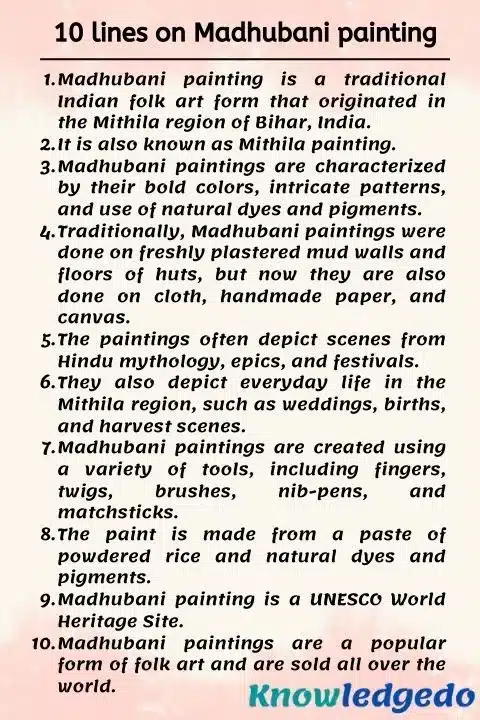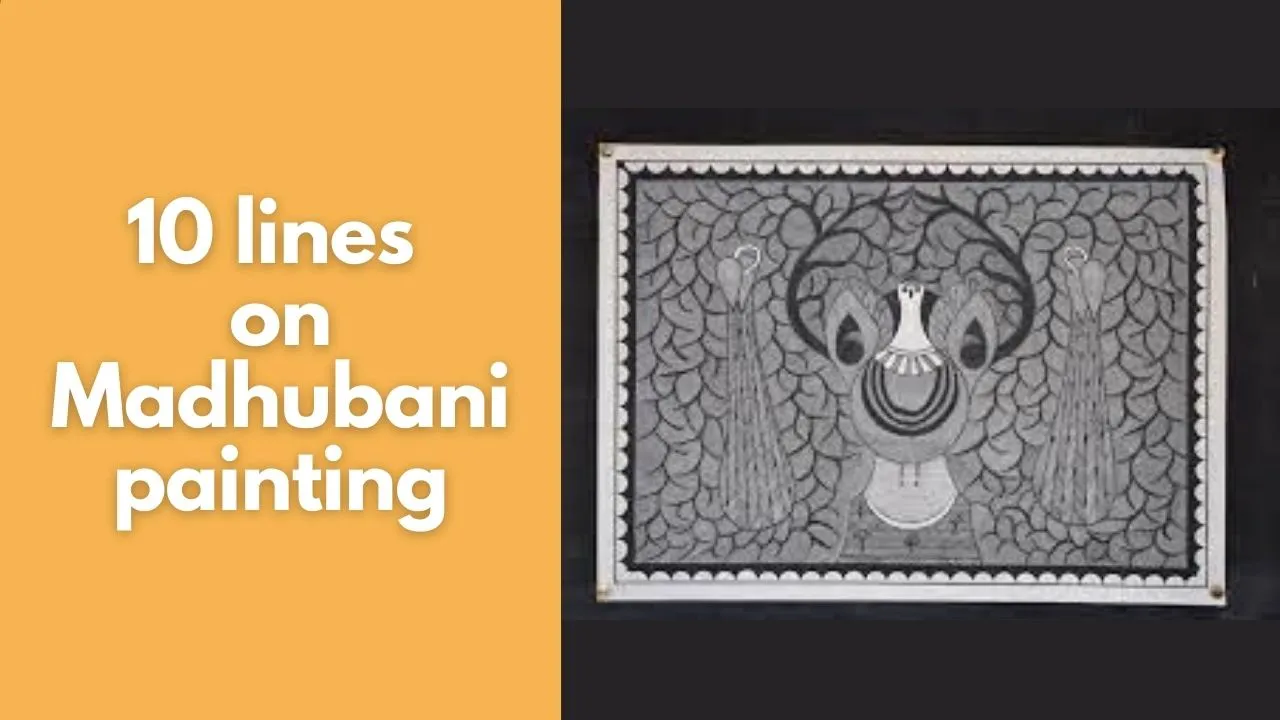Today, we are sharing 10 lines on Madhubani painting in English. This article can help students who are looking for information about 10 lines on Madhubani painting. These lines are straightforward and easy to remember. The level of difficulty is moderate, making it accessible for any student to write on this topic.
This article is generally useful for class 1,class 2,class 3,class 4,class 5,class 6,class 7,class 8,class 9,class 10,class 11,class 12
10 lines on Madhubani painting
1) Madhubani painting is a traditional Indian folk art form that originated in the Mithila region of Bihar, India.
2) It is also known as Mithila painting.
3) Madhubani paintings are characterized by their bold colors, intricate patterns, and use of natural dyes and pigments.
4) Traditionally, Madhubani paintings were done on freshly plastered mud walls and floors of huts, but now they are also done on cloth, handmade paper, and canvas.
5) The paintings often depict scenes from Hindu mythology, epics, and festivals.
6) They also depict everyday life in the Mithila region, such as weddings, births, and harvest scenes.
7) Madhubani paintings are created using a variety of tools, including fingers, twigs, brushes, nib pens, and matchsticks.
8) The paint is made from a paste of powdered rice and natural dyes and pigments.
9) Madhubani painting is a UNESCO World Heritage Site.
10) Madhubani paintings are a popular form of folk art and are sold all over the world.

5 lines on Madhubani painting
1) Madhubani art, a folk treat,
2) With bold colors and patterns neat.
3) From Mithila’s land, it shines,
4) Depicting Hindu scenes and designs.
5) A vibrant heritage, forever enshrined.
FAQ
Answer: There are five main styles of Madhubani painting:
~Bharni: This style is characterized by its bold colors and intricate patterns. It is often used to depict scenes from Hindu mythology and epics.
~Kachni: This style is known for its use of bright colors and geometric patterns. It is often used to depict everyday life in the Mithila region.
~Tantrik: This style is characterized by its use of symbols and motifs from Tantric Hinduism. It is often used to create paintings that are used for spiritual purposes.
~Godna: This style is known for its use of black and white colors. It is often used to create tattoos and other decorative designs.
~Kohbar: This style is characterized by its use of natural dyes and pigments. It is often used to depict scenes from nature.
Answer: Traditionally, Madhubani paintings were done on freshly plastered mud walls and floors of huts, using fingers, twigs, nib pens, and matchsticks. The paint was made from a paste of powdered rice and natural dyes and pigments.
Today, Madhubani paintings can be done on a variety of surfaces, such as cloth, handmade paper, and canvas. Artists may also use a variety of tools, such as brushes and sponges. However, traditional materials and techniques are still widely used.
Answer: Madhubani paintings are relatively delicate, so it is important to care for them properly. Here are a few tips:
~Avoid exposing your painting to direct sunlight or heat, as this can cause the colors to fade.
~If your painting is on paper or canvas, you may want to frame it to protect it from dust and dirt.
~If your painting is on a hard surface, such as wood or metal, you can apply a thin coat of varnish to protect it from scratches and stains.
~To clean your painting, simply wipe it gently with a soft, damp cloth. Avoid using any harsh chemicals or detergents.
